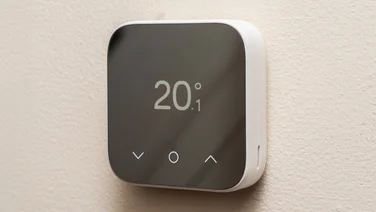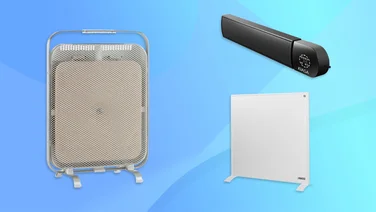To help us provide you with free impartial advice, we may earn a commission if you buy through links on our site. Learn more

- Flexible configuration
- Brilliantly simple touchscreen controller
- Will save you money in the long term
- Expensive initial payment
- Design could be more attractive
Honeywell Evohome smart thermostats were the first multiroom heating system, and it’s still the only product that’s built with this in mind. However, with this flexibility and individual control comes expense, and Evohome is just about the most expensive system money can buy.
Honeywell Evohome review: Price and installation
At its cheapest, Evohome costs £215, which nets you the touchscreen controller and the remote boiler relay for on/off control. In this mode, the system acts as a smart heating system, with the touchscreen controller using its internal temperature sensor. You can add an additional boiler relay if you’d like to control hot water. If you want to control a modulating boiler, you have to buy the more expensive OpenTherm relay.
Operating like this, the Evohome is a rather expensive waste. It’s when you add the TRVs (£59 each, but look for packs to save money) that Evohome really starts to come into its own. By replacing your existing dumb TRVs with the smart ones, you get complete room-by-room control of your heating.
DIY installation is possible, but professional installation is better and will cost around £100, depending on the complexity of installation and the number of radiators you want to control.
Honeywell’s TRVs are easy to fit, shipping with adaptors to fit most radiators. We have to say that the TRVs aren’t the most attractive, suffering from a rather plain industrial look thanks to the glossy white plastic. Given that most TRVs are hidden out of sight, you can live with the problem. For underfloor heating you can use a single-zone thermostat and wireless relay for a single zone; there are multi-zone controllers, too.

Honeywell Evohome review: Configuration
Configuration of the TRVs is super flexible, and multiple units can be combined into a single zone. This is particularly handy if you’ve got rooms with multiple radiators.
Evohome is controlled directly from its touchscreen controller. It’s brilliantly simple to use, giving you an overview of every zone in your home, and it connects via Wi-Fi, so you can use the Evohome app without having to install a separate hub.
Your first job is to set a schedule for each zone. A setup wizard helps you, but we found it easier to take each room and control it separately. For example, you may want your bathroom to heat up early so it’s warm when you get up; you can fire up the kitchen a little later, so it’s warm when you get downstairs.
Schedules can be adjusted by day, too, so you can run your heating to suit your activity, such as changing things for the weekend when you may lie in for a bit.
Schedules can conveniently be copied between zones and days, so you don’t have to program every single change. We found that it took us a few weeks to get our schedules right, but we ended up only heating zones as we needed them.

Honeywell Evohome review: Features and performance
By not having to heat the entire house, Evohome will save you more money on heating bills than other systems; however, the initial outlay means that the system will also take longer to pay for itself.
There will be times where your schedule doesn’t quite work, such as if you come home early from work. At this point, Evohome is also exceptionally flexible, and you can manually dial up the temperature from the controller, app or by spinning the TRV’s rotating head, and using the integrated screen to see the set temperature.
From the controller or app, the temperature change can be made permanent, or you can set an end time (this defaults to the next scheduled change). From the TRV, temperature changes are made until the next scheduled change.
We found the TRVs a little loud, and you can hear a small mechanical whine as they turn on. It took us a few weeks to get used to this in the bedroom, but we could sleep through the noise in the end.
As well as the default schedule, Evohome has four programmable quick actions: Economy reduces zone temperatures by 3°C; Away sets every zone to a pre-set temperature, which is handy if you go on holiday; Day off changes the schedule to match the weekend, so you’re warm if you’re home during the week; and there’s a Custom mode, which lets you set your own special schedule. We use Custom mode as a guest mode, turning up the heat in the spare bedroom when we have people to stay.
Everything you can do from the touchscreen controller, you can also do from the smartphone app, either remotely or in your home, bar copying schedules between zones. Honeywell has designed the app so you can see all the different zones and related temperatures directly on the home screen.
There’s no built-in geofencing, so you can’t turn off your heating automatically when you go out. Alternatively, you can use IFTTT to adjust your heating automatically. Using the Life360 service, for example, you can turn off your heating when you go out and turn it on when you return.
Amazon Alexa and Google Home are both supported. You can ask either for the current temperature or set a new temperature. The Alexa Skill was slightly flaky at launch, but we’ve since found both it and the Google Assistant equivalent to be rock solid.
Honeywell Evohome review: Verdict
There’s no doubting that Evohome is expensive, but it’s the only system designed from the ground up to give room-by-room control. For the ultimate flexibility, then, it’s the best system to buy, and it will ultimately save you more money on running costs.
| Key specifications | |
|---|---|
| Remote thermostat | Yes |
| Hot water support | Yes |
| Individual radiator control | Yes |
| OpenTherm support | Yes |
| Voice assistant support | Alexa, Google Assistant |
| IFTTT | Yes |
| Warranty | Two years RTB |
| Price | £215 |






